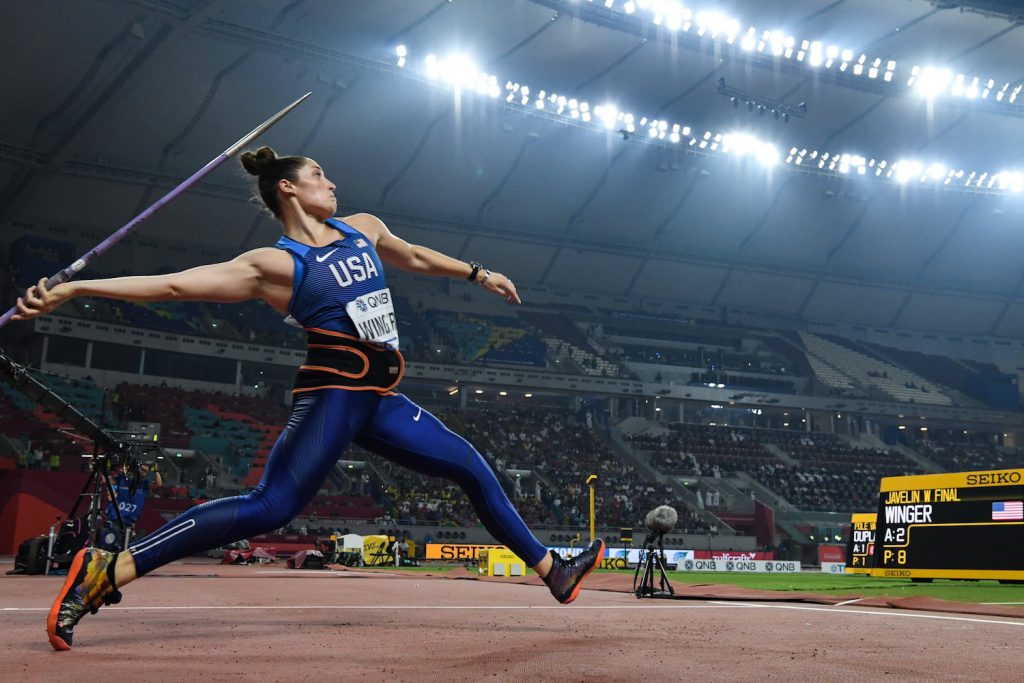The Evolution of Throwing

With the Tokyo Olympics on the horizon, Kara Winger is training hard. “I want to make the top eight in Tokyo,” she says. “The absolute dream would be to medal.”
The 35-year-old female javelin thrower from the U.S. focuses a lot of her efforts on strengthening her arms and shoulders. She swims, lifts weights, works with exercise bands—techniques, she says, that keep “the rotator cuff healthy and happy and mobile.” And although most of her training has been done in a face mask, “things are close to normal,” she says.
Twice a week Winger throws the javelin, sending it flying over and over far into the distance. Her personal best stands at 218 feet 8 inches, but in Tokyo, she is hoping for more.
Winger is perfecting a uniquely human feat. Compared with other animals, humans are poor climbers, poor jumpers, and clumsy sprinters. Throwing is one of the few physical skills at which Homo sapiens truly excels.
Adult male chimpanzees, for instance, can throw projectiles overhand at about 20 mph, but 8-year-old boys are able to hurl baseballs at 40 mph. For some top professional baseball pitchers, that number nears 100 mph–and a record-setting fastball topped 105 mph.
“Overhand throwing is one of the relatively small number of adaptations that distinguish us from other species and that played a huge role in our evolutionary history,” says Robert Deaner, a psychology professor and biological anthropologist at Grand Valley State University.
In 2018, he and his colleagues argued that hunting and warfare drove the evolution of throwing, with the latter being of particular importance. If you threw your stones and spears well, he says, you were more likely to survive conflicts and pass on your genes to the next generation.
We automatically reach for stones when threatened or starting a fight. The projectiles are important weapons in many hunter-gatherer societies—and they can make for powerful tools.
For years, however, the evolution of throwing remained understudied. That is now changing. Several anthropologists are working to uncover the origins of human throwing, reaching for new tools such as employing athletes and using sports as a model for their inquiry.
The earliest-discovered wooden spears include artifacts dating back 400,000 years from Clacton-on-Sea in the U.K. and 300,000 years from Schöningen in Germany. These finds spurred arguments about how important throwing might have been for humanity’s ancestors.
Until recently, the prevailing view among many researchers was that these ancient spears from the Pleistocene Epoch were too bulky to be thrown far, making them a rather ineffective projectile. Experiments showed that such spears could not accurately hit a target if thrown from more than 16 to 32 feet. As such, the reasoning went, they were probably thrusted rather than thrown.
However, new research conducted by archaeologist Annemieke Milks, of the Lower Saxony State Office for Heritage in Germany, and her colleagues, challenges that view. Instead of using unskilled volunteers, as was typically done previously, Milks employed trained javelin athletes to throw replicas of Schöningen spears.
Winger is perfecting a uniquely human feat.
Before she became an archaeologist, Milks was a professional violinist, and it struck her as bizarre that scholars were testing the performance of a tool using people who had no experience with it whatsoever. “If you had an archaeologist pick up a Stradivarius in 1,000 years’ time, and then try and have a play, even after a month of playing that instrument, you’d be like, ‘It sounds really bad.’ No—you sound really bad,” she says, “For me, it was an extraordinary ‘aha’ moment.”
For her study, published in 2019, Milks chose six male javelin athletes and showed that they were able to pitch Schöningen-like spears to distances over 98 feet, with 85 feet being the average distance. What surprised Milks was that the athletes found the replicas quite modern: similar in balance and weight to contemporary spears. “Something that was designed 300,000 years ago feels very comfortable for athletes today,” she says.
Milk’s newest research, still unpublished, shows that the Bondongo and BaYaka peoples of the Congo Basin can make their spears fly even more accurately than the Western athletes she has studied. All this evidence taken together suggests that 300,000 years ago, H. sapiens might have been very proficient at using thrown weapons.
Harvard University anthropologist Neil Roach and his colleagues have also employed trained athletes to study the evolution of throwing. Specifically, to understand human anatomical adaptations to this form of movement, they recorded college baseball players pitching using an infrared motion capture system.
The researchers found that humans are so good at throwing because our body stores energy in our shoulders. Scientists refer to this banked power, which puts a strain on our bodies, as “elastic energy storage.”
“We stretch the ligaments and tendons that are in the shoulder much like a slingshot and recover a lot of energy out of that to produce these really fast throws,” Roach says. Such slingshot throwing, he argues, was likely made possible by three anatomical changes that occurred during human evolution: expansion of the waist, lowering and repositioning of the shoulders, and the emergence of low humeral torsion (the twisting of the upper arm bone that enhances elastic energy).
For a long time, scholars have hotly debated the anatomical changes linked to human throwing. In addition to the importance of humeral torsion, some scientists believe that clavicle (collarbone) length mattered. They argue that the shoulder positioning and short clavicles seen in Homo erectus meant they could not throw as well as modern humans.
But based on the results of Roach’s experiments with athletes, as well as studies of fossil and modern skeletal measures, Roach argues that the capacity for high-speed throwing was already present in H. erectus—placing humanity’s particular talent for pitching all the way back to 2 million years ago.
As studies by Milks and Roach show, using sports as a model for studying movement and the human body can challenge old views on the evolution of throwing. Jay Stock, an anthropologist at Western University, has championed this idea.
In 2020, Stock and his colleagues published a review on “human athletic paleobiology” or using athletes and sports to put evolutionary theories to the test. Stock notes that for researchers interested in human evolution, “one of the big ‘unknowns’” is what factors—such as environmental effects, diet, or activity patterns—drove the variation in the fossil record.
Experiments with athletes, as well as fossil and modern skeletal measurements, place humanity’s particular talent for pitching all the way back to 2 million years ago.
“Studying athletes helps us to understand how the things that we do in our everyday lives influence our physiology and our skeletons,” Stock says. “To me, it is one of the areas of the discipline with tremendous promise.”
Though Olympian Kara Winger has not participated in such a study herself, she is open to it—provided it doesn’t disrupt her training. Winger has always recognized that her sport of choice is part of a longstanding human tradition, going back millennia.
“My dad, when I first started throwing javelin, he was like, ‘Someday, we will go and hunt boars with spears,’” she says with a chuckle. She adds that she is always aware that she is engaged in an activity that humans have been practicing for a long, long time, “which is super cool.”

































